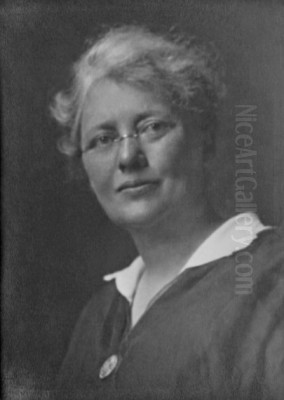
Mary DeNeale Morgan stands as a significant figure in the annals of American, and particularly Californian, art history. Active during a vibrant period of artistic development on the West Coast, she became renowned for her evocative depictions of the Monterey Peninsula landscape. Working primarily in pastel, oil, and watercolor, Morgan captured the unique beauty of her adopted home, Carmel-by-the-Sea, leaving behind a legacy as both a prolific artist and a vital community member. Her life (1868-1948) spanned a transformative era, and her work reflects a deep connection to the natural world and the burgeoning art scene of Northern California.
Early Life and Artistic Foundations
Born in San Francisco on May 24, 1868, Mary DeNeale Morgan entered a world brimming with post-Gold Rush energy and cultural growth. Her family background provided a blend of practical and intellectual influences; her father worked as an engineer in nearby Oakland, while her mother, a Yale graduate of French-Canadian heritage, likely fostered an appreciation for culture and learning. This environment seemingly nurtured Morgan's innate artistic inclinations from an early age.
Her formal artistic training commenced in 1886 when she enrolled at the California School of Design (also known at various times as the San Francisco Art Institute or associated with the San Francisco Art Association). This institution was the crucible for many of California's most important artists. During her time there, which spanned approximately eight years albeit with interruptions, Morgan studied under several influential figures who shaped the course of Californian art.
Among her most notable instructors was William Keith, a towering figure in landscape painting, known for his Tonalist and Barbizon-influenced depictions of California's grandeur. Learning from Keith likely instilled in Morgan a deep reverence for nature and the skills to translate its moods onto canvas. Another key mentor was Virgil Williams, the director of the School of Design for many years, who emphasized academic rigor and traditional techniques.
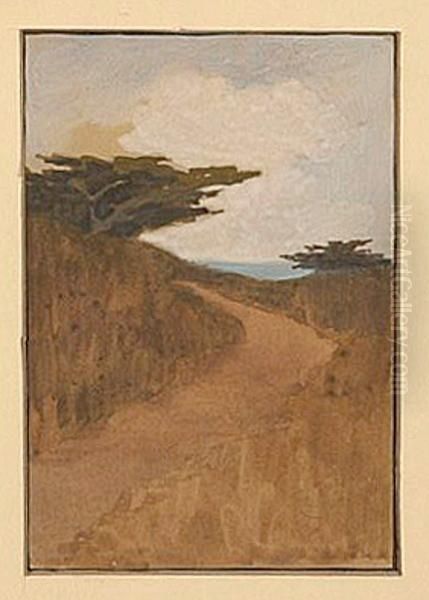
Morgan also received instruction from Amédée Joullin, known for his genre scenes and Native American subjects, and Arthur Mathews, a pivotal figure in the development of the California Decorative Style, known for its blend of Symbolism, Art Nouveau, and classical motifs. Exposure to these diverse artistic philosophies provided Morgan with a broad technical and aesthetic foundation, even though her own path would lead primarily towards landscape painting. Although her formal studies faced interruptions, her dedication to art remained unwavering, and she continued to create prolifically from roughly 1894 until the end of her life.
Carmel-by-the-Sea: An Artist's Haven
The Monterey Peninsula, with its dramatic coastline, unique flora, and ethereal light, began to attract artists and writers in the early 20th century. Mary DeNeale Morgan first visited the nascent village of Carmel-by-the-Sea in 1903. She was captivated by its natural beauty and the burgeoning creative community. By 1910, she had made Carmel her permanent home, building a studio and immersing herself in the town's artistic and social life.
Carmel provided the perfect backdrop for Morgan's artistic sensibilities. She became particularly known for her depictions of the region's iconic Monterey Cypress trees, clinging precariously to coastal cliffs, as well as the local pines and pervasive ivy. Her canvases often featured the rolling sand dunes, historic adobe structures remnants of California's Spanish past, and the ever-changing Pacific Ocean. She worked tirelessly to capture the specific atmosphere and light of the peninsula.
Morgan quickly became an integral part of the Carmel art colony. She was one of the founding members of the Carmel Art Association in 1927, an organization established to exhibit the work of local artists and promote Carmel as an art center. Her involvement alongside other prominent artists like William Ritschel underscored her commitment to fostering a supportive environment for her peers. Her deep engagement extended beyond the purely artistic; she was an active member of the Forest Theater Association, contributing to the town's unique outdoor theatrical tradition, and participated in the local Episcopal Church community.
Educator and Community Leader
Beyond her own prolific output, Mary DeNeale Morgan dedicated significant energy to art education and community enrichment in Carmel. Her teaching career began around the time she settled permanently in the village. Starting in 1910 and continuing for three years, she taught painting and drawing classes during the summer sessions organized by the Carmel Arts and Crafts Club, sharing her skills and passion with aspiring artists.
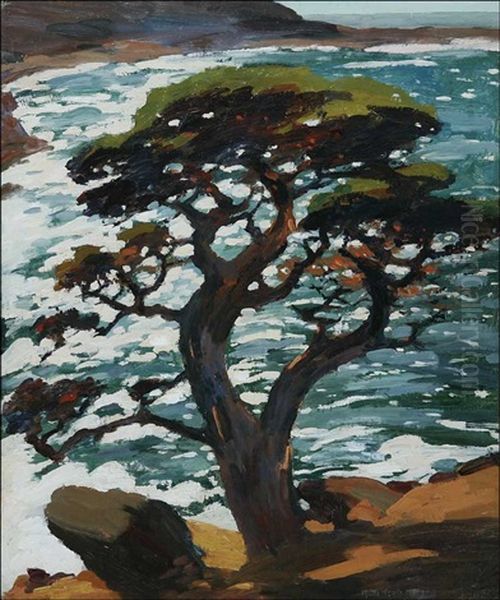
She played a key role in organizing "Open Studio" events, which allowed local artists to exhibit and sell their work directly to the public, fostering a connection between creators and patrons. Her organizational skills were further utilized when the renowned American Impressionist William Merritt Chase arrived to teach a major summer school course in Carmel in 1914. Morgan not only attended Chase's classes as a student, absorbing insights from the master painter, but also served as his secretary during his Carmel tenure (1915-1916), likely handling administrative tasks for his popular classes at the Carmel School of Art.
Following Chase's departure, Morgan's leadership role solidified. From 1917 to 1925, she served as the Director of the Carmel School of Art, guiding its curriculum and administration. For a period, she shared directorial duties with Matilde Sandor. By 1918, she became the sole director of the Carmel Summer School of Art, a position she held until her retirement from the role in 1926. Her long tenure demonstrates her commitment to nurturing artistic talent within the community. She also generously offered free art classes at times and contributed articles on art to local newspapers, further cementing her role as a central figure in Carmel's cultural life. Her prominence was recognized externally as well; a 1914 New York Times article highlighted her as one of Carmel's distinguished artists.
Artistic Style, Mediums, and Subjects
Mary DeNeale Morgan developed a distinctive style characterized by both sensitivity to nature and a confident handling of her chosen mediums. While she worked in oil, watercolor, and occasionally etching and tempera, she became particularly celebrated for her mastery of pastels. This medium allowed for both delicate tonal gradations and bold, direct strokes of color, well-suited to capturing the fleeting effects of light and atmosphere on the Monterey coast.
Her subject matter remained consistently focused on the landscapes of the Monterey Peninsula. She possessed an intimate knowledge of the region's unique features: the gnarled, wind-swept cypress trees of Point Lobos and the 17-Mile Drive, the sturdy Monterey pines, the coastal redwood groves found slightly inland, the shifting patterns of sand dunes, the textures of historic adobe buildings, and the vast expanse of the Pacific Ocean under varying conditions of light and weather. She rendered these scenes with what contemporaries described as both delicate and bold brushwork, suggesting a versatile technique adaptable to different moods and textures.
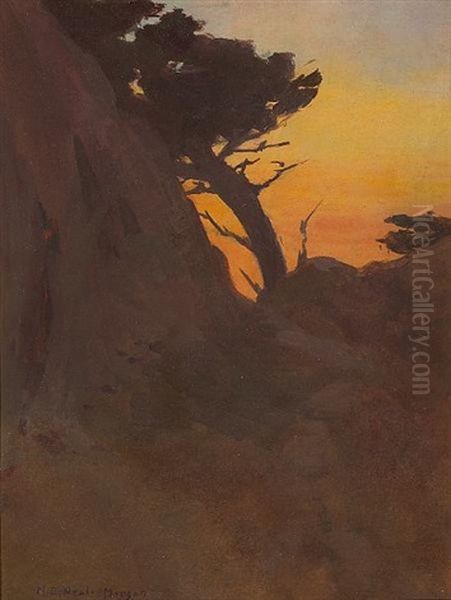
Morgan's work is often situated within the broader context of California Impressionism, yet it retains a unique character. Her palette was noted for its richness, effectively conveying the vibrant blues of the sea, the deep greens and ochres of the foliage, and the warm glow of California light. While some critics of her time may have viewed her work as "conservative" compared to emerging modernist trends, others recognized her ability to incorporate elements of modern sensibilities—perhaps in her use of color or compositional choices—while maintaining a strong foundation in traditional draftsmanship and observation. Her art was not merely representational; it conveyed a deep emotional connection to the landscape and, according to some interpretations, a philosophical reflection on the enduring beauty and inherent transience of nature.
Representative Works and Recognition
Throughout her long career, Mary DeNeale Morgan produced a significant body of work, exhibited frequently and acquired by collectors. While a comprehensive catalogue is challenging to assemble, several specific works are mentioned in historical accounts, offering glimpses into her oeuvre.
One notable example is Cypress Trees, an oil painting dated 1925. This work, held in the collection of the John D. Relfe family, likely exemplifies her fascination with the iconic Monterey Cypress, showcasing her skill in rendering their distinctive forms and textures using the richness of oil paint.
Other titles attributed to her include Juniper Street, suggesting a focus on specific Carmel locales, and works like Cypress and Blue Sea and Sunset Glow, whose titles evoke the dramatic interplay of land, sea, and light that defined her primary subject matter. These titles point to her consistent engagement with the coastal environment.
A poignant discovery was made after her death: an unfinished painting titled A Garden in the Mist. This late work, which she was reportedly working on just a week before she passed away, speaks to her lifelong dedication to her craft and her enduring interest in capturing atmospheric effects and the subtleties of the natural world.
Morgan's work received considerable recognition during her lifetime. She exhibited regularly at venues such as the California School of Design (San Francisco Art Association) galleries and the Carmel Art Association. Her paintings were praised by critics and sought after by patrons. A significant accolade came in 1928 when The New York Times named her one of America's most distinguished women artists, a testament to her national reputation beyond California.
Personal Life and Enduring Legacy
Mary DeNeale Morgan dedicated her life almost entirely to her art and her community. She never married and lived for many years with her mother and sister in Carmel. Alongside her painting, she reportedly operated a pottery shop, adding another dimension to her artistic endeavors and potentially providing a source of income. Her focus remained steadfastly on her creative work, as evidenced by the fact she was actively painting almost until the moment of her death.
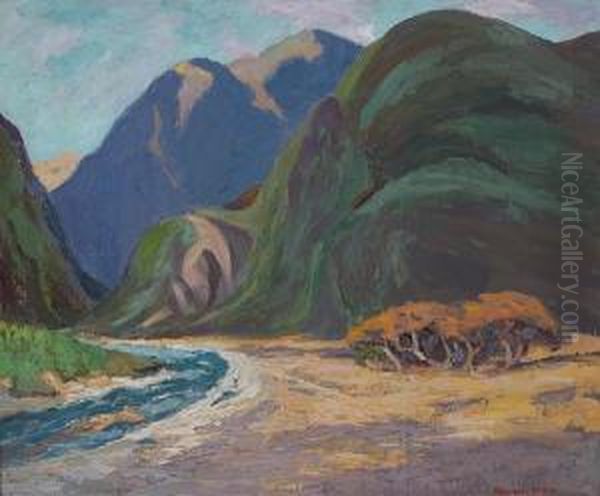
Her commitment extended to civic engagement. She was recognized as an early conservationist in Carmel, actively participating in efforts to protect the natural beauty that inspired her art. Notably, she was involved in movements opposing developers whose plans threatened the pristine character of the Monterey Bay coastline. Her participation in the women's rights movement further highlights her engagement with the social issues of her time.
Mary DeNeale Morgan passed away in Carmel on October 10, 1948, at the age of 80. She left behind a legacy far exceeding her individual canvases. As an artist, she masterfully captured the unique spirit of the Monterey Peninsula, contributing significantly to the canon of California landscape painting. Her contemporaries included other notable Carmel and Monterey artists such as Armin Hansen, known for his vigorous marine paintings, the Impressionist E. Charlton Fortune, and the Tonalist landscape painter Percy Gray, among many others who formed the vibrant artistic milieu she inhabited.
As an educator, she mentored generations of students through her long association with the Carmel School of Art. As a community leader, she was instrumental in founding the Carmel Art Association and actively participated in the cultural and civic life of her adopted town. Her life and work reflect the challenges and opportunities faced by female artists in the early 20th century, demonstrating resilience, dedication, and a profound connection to place. Mary DeNeale Morgan remains an important and respected figure, celebrated for her artistic achievements and her enduring contributions to the cultural heritage of California.